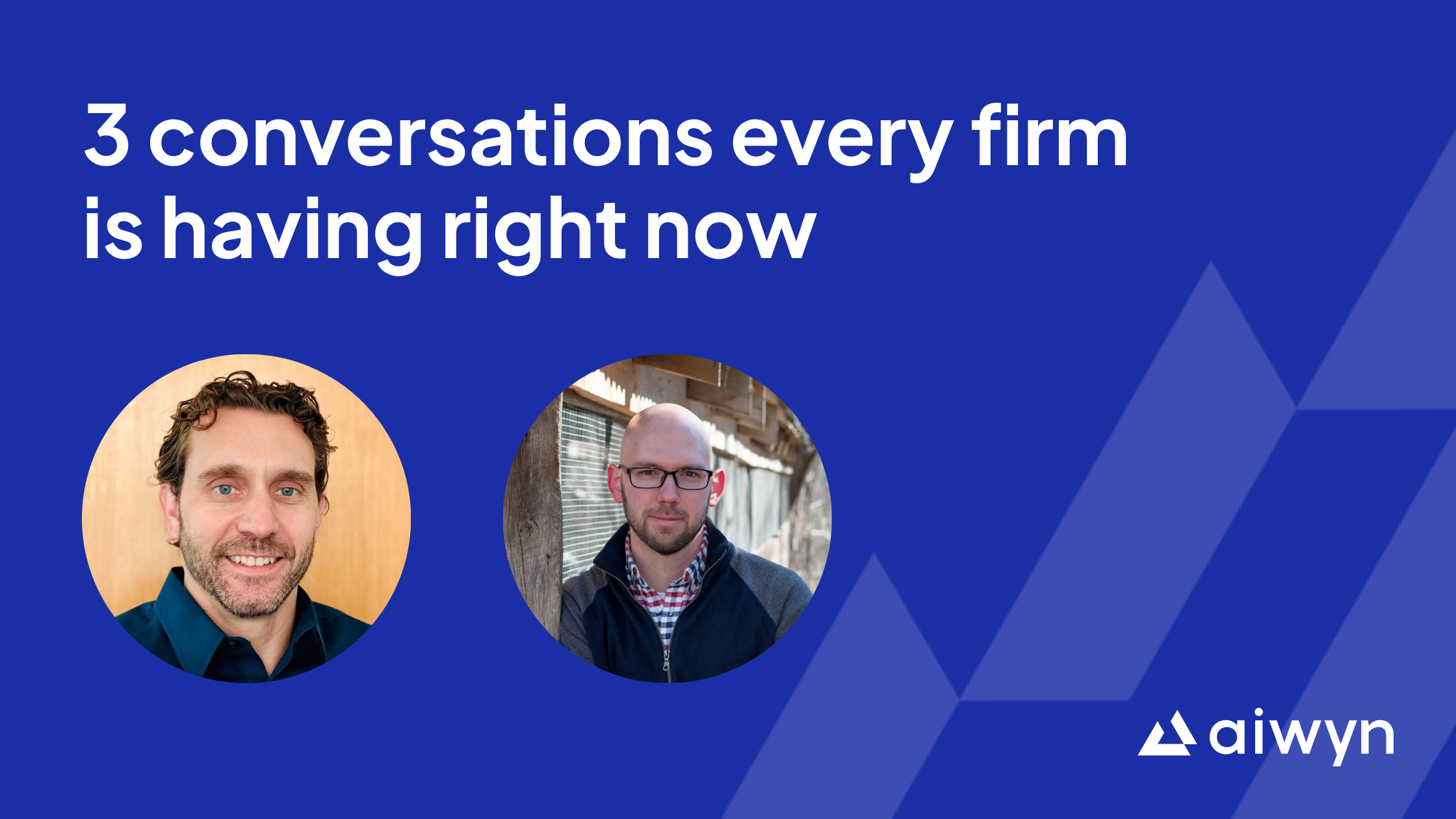After speaking with hundreds of accounting firms, from regional leaders to Top 100 trailblazers, three key conversations continue to surface across boardrooms, partner meetings, and offsites. These are not theoretical trends. They are real decisions firm leaders are working through now.
In a recent webinar with Accounting Today, Aiwyn President, Levi Morehouse, and VP of Services & Innovation, Chad Osgood, joined moderator, Chris Gaetano, to explore these topics in depth.
Here is a quick recap of the three most common and timely conversations.
1. “How do we transition from WIP billing to value billing?”
Traditional time-based billing is facing more scrutiny than ever. With persistent staffing shortages, rising overhead, and growing client demand for predictability, firms are being pushed to re-evaluate how they price and deliver services.
But shifting from WIP to value-based billing isn’t as simple as updating your rate card. As Chad shared during the webinar: “You can’t just change pricing. You have to change process.”
Value billing isn't about flipping a switch, it’s about creating the infrastructure to support the shift. That means:
-
Writing clearer, more defined engagement letters
-
Scoping work with more intention up front
-
Enabling partners and staff to confidently communicate value not just hours
Some of the most forward-thinking firms are experimenting with blended billing models, which combines fixed-fee engagements, milestone-based billing, and prepayment flows tied to signed engagement letters.
Key takeaway: These aren’t just pricing experiments. They’re strategic moves that reflect a broader shift where billing is no longer just a finance function, it’s a key part of the client experience.
2. “How do we get more out of Microsoft tools?”
Nearly every accounting firm uses Microsoft: Outlook, Excel, Word, Teams, SharePoint. It’s the default digital toolbox. But for many firms, these tools are underutilized, fragmented, or misaligned with how the firm actually works. Levi comments, “The best technology move many firms can make right now? Start treating Microsoft like infrastructure, not just software.”
The key shift is mindset. Instead of viewing Microsoft apps as standalone utilities, leading firms are beginning to treat them as the foundation for operational excellence. This means:
-
Building out SharePoint with metadata, permissions, and naming standards
-
Using Teams to drive structured collaboration versus chat only
-
Connecting workflows across Microsoft 365 apps for better efficiency and consistency
Key takeaway: When tools like Teams and SharePoint are set up with structure and consistency, firms can reduce waste, improve collaboration, and simplify how work gets done.
3. “How do we create a better client experience when we use multiple systems?”
For many firms, the client experience is unintentionally fragmented. A client might need to log into one system to upload tax documents, another to sign an engagement letter, a third to view invoices, and yet another to send messages or schedule a meeting. Levi highlights, "It's not about less tech. It's about the right tech, in one place."
The problem isn’t that firms use multiple tool. It’s that clients can feel the seams between them. That friction leads to confusion, lower adoption, missed deadlines, and delayed payments. Internally, it also means more time spent answering questions, duplicating messages, and tracking down client responses across disconnected platforms.
The opportunity? Unify the experience at the front door. Leading firms are doing this by:
-
Creating one consistent portal or experience layer for clients to access key tasks
-
Ensuring branding, messaging, and tone are consistent across every touchpoint
-
Automating the handoff between systems behind the scenes, so the client never feels the complexity
The result is a more modern, more professional, and more seamless experience, without forcing the firm to consolidate every internal tool.
Key takeaway: A better client experience starts with simplifying what clients see. That might mean consolidating systems or at least giving clients one consistent place to upload documents, sign forms, pay bills, and ask questions. Even if your firm uses multiple systems internally, clients should not have to navigate all of them.
Final thoughts: Start where you are
The biggest message from the webinar? Just start.
You don’t need a perfect roadmap to begin transforming how your firm operates. Whether you’re rethinking billing models, trying to unlock more value from Microsoft, or working to deliver a more cohesive client experience. The most important thing is to take the first step.
Something Chad often says is, "Don't worry about the middle when you're in the beginning. Clarity comes with momentum."
Transformation doesn’t happen all at once. But it does happen with intention, small wins, and steady progress. Remember that it's not about unlimited budgets or internal tech teams. The firms making the most progress are the ones that decide to act. To run a pilot. To align one process. To clean up one system. And then keep going.


